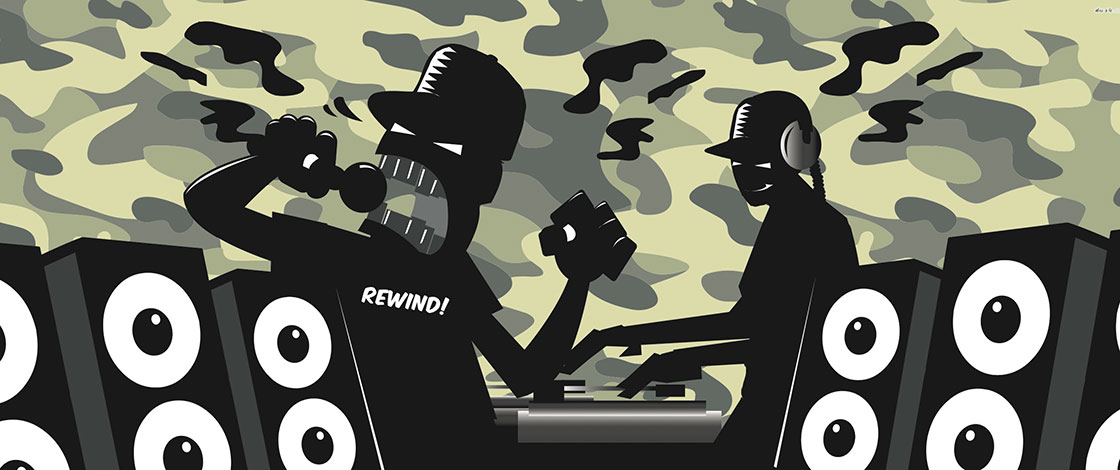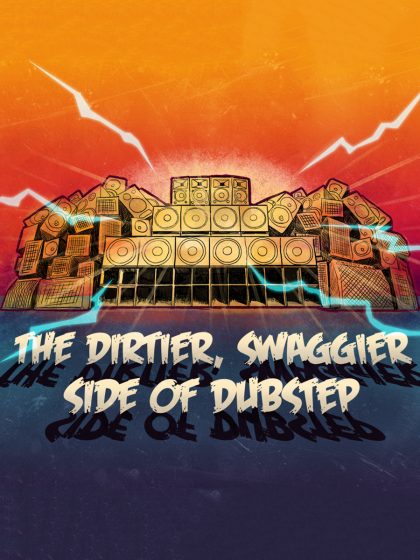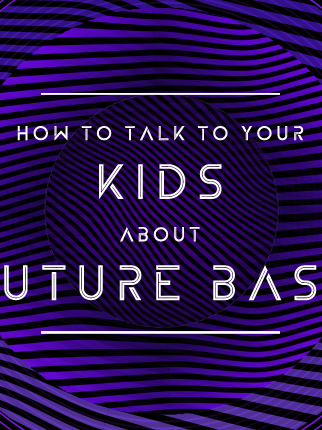How to Talk to Your Kids About Drum & Bass

Electronic music as a whole has a wide and seemingly disparate family tree that makes it hard to locate any one specific root or source from which the rest of the ever-evolving genre has evolved. Nowhere does the complex nature of electronic music make itself more known than in the overwhelming complexity of the genre we have come to know as drum & bass. Seemingly drawing not only from all branches of the electronic music tree, drum & bass is like a postmodern carnivore that has consumed and integrated all forms of music output over the course of the past century and spit them back at us in a fractured yet completely unique way.
The beauty of drum & bass is that it is both retro and futuristic, complex merely as the result of its fractured and often multifaceted influences, and yet relatively accessible and pleasing to advanced and neophyte listeners alike. As a music scholar, I’m fascinated by the way drum & bass reflects just how far sampling and remix culture can go. And yet, while the boundaries of tempo, technology and experimentation have resulted in a language and culture that is all its own, there is something primal about the groove and beat that transcends the intellect and dives straight in for the soul, able to unleash a heaving mass of bodies crashing against each other in a kind of primitive fever just as likely to unlock the keys to the universe to someone strapped in on their headphones, contemplating the stars, existence, life. There is something holy in the way that a breakbeat can be chopped and reformed into something new, and drum & bass in particular seems to have created a kind of religious fervor in its listeners and followers that is far beyond what other music genres seem capable of pulling.
“From festival to warehouse to art opening to renegade desert party and everything in between, drum & bass is a sound that wants to punish and heal you at the same time.”
Rivaled perhaps only by techno, drum & bass is in itself a kind of religion, spiritual as much as it is an expression of unbridled aggression and frenzy. It is able to induce a higher state of consciousness as much as it is to release a kind of primordial energy that many have never fully realized until they are side by side with fellow drum & bass heads, getting pummeled by hyperkinetic breakbeats and chest-rattling basslines.
We’re getting ahead of ourselves, but where else can we begin? How else can we deconstruct a genre that, by its very nature, resists being dissected and reduced to a series of clinical observations? Breakbeats, dubplates, basslines, rewinds, rollers, mentasms, Jamaica, Bristol, UK, or London… there is no one story or history that can truly capture all that could possibly be told in a style that by its very nature seeks to erase the line between mind and body and unite them into one.
This culture, this world—for some, it’s like offering a glimpse into a secret society, a tribe of snobby culture purists mixed with straight-up nutters who have just discovered the hyperkinetic sound and want to spread the love and brock the fuck out every week to their favorite DJ. For others, it’s a vibe, an energy, a groove, or something to put up with until the next big dubstep act comes on at the festival. But that’s the beauty of drum & bass. From festival to warehouse to art opening to renegade desert party and everything in between, it’s a sound that wants to punish and heal you at the same time.
But let’s put all that aside for now and build our own junglist from scratch. Let’s assume that our junglist is well-versed in the history and knowledge of ambient, techno and acid house—from the likes of John Cage, all the way through to Kraftwerk, and beyond into Phuture or Jesse Saunders. Just like in elementary school when you learn about the Pilgrims and Christopher Columbus, it’s only one-half of the story, or in our case, one strand of the DNA of drum & bass as the real heart and soul of music can be traced back to Jamaican sound system culture. We’ll talk about breakbeats in a moment, but it can’t be emphasized enough just how important Jamaican sound system culture is to the development and continued evolution of all electronic music culture. Without dub and reggae and, more importantly, the culture that formed around these forms of musical expression, there is no jungle, there is no drum & bass, trap, grime, footwork, dubstep, or hip-hop; there is no MC, there is no rewind, dubplate, or this obsessive determination to harness the Babylonian technology of the Man and push it to its absolute limits in search of a unique form of expression that speaks to an underground culture all its own.
Imagine neighborhood streets and parking lots transformed into asphalt dancefloors with DJs playing special versions of popular songs and MCs providing running commentary, “chatting” over the beats, while the crowd roars in appreciation when a particular moving bassline or groove is dropped. It’s proto-rave culture through and through!
Do yourself a favor and watch the 1978 film Rockers. Not only will you find a treasure trove of sample sources used in early jungle/drum & bass anthems, you’ll also develop an new understanding of street vernacular that is used to this day by bassheads near and far. Even better, as far as our budding junglist is concerned, the film schools the viewer on how a renegade tribe of underground musicians not only resists flashy clubs and mainstream music, but creates something much deeper along the way.
More important and to the point, it’s out of sound system culture that production wizards like Duke Reid, Sir Coxsone, and King Tubby push the boundaries of studio technology and find unique and exciting ways to develop a new sound. While concepts like reverb, echo, and equalization have been the mainstays of recording technology throughout the 20th century, in the hands of Jamaican producers and engineers, these features were used to shape and create what was essentially a new language. Tracing the lineage from Lee “Scratch” Perry’s infamous Black Ark studio to the home studios of early breakbeat hardcore artists like 2 Bad Mice, Acen, and hip-hop artists like N.W.A., we begin to understand how dance music in particular not only shifted from live music to the sample-based consumption of funk and soul records, but introduced audiences and consumers to a new way of listening. Percussive breakbeats in particular went on to become the syntactical backbone of genres as varied as hip-hop, breakbeat hardcore, UK garage, jungle, and drum & bass.
But what is a breakbeat? In its rawest, classic form, DJs and producers would spend their free time digging through countless crates of vinyl records looking for those moments in a song when the percussive breaks or beats of a tune were clean and clear enough to sample. This was often found in the “breakdown” sections of songs where the drummer would solo, or sometimes there were moments in a song where a simple roll or fill used to bridge one section to another would be enough. Regardless, it was from this vinyl source that producers would then “sample” or record the “break” into a sampler where they could then “chop” it into smaller elements, manipulate, shape, stretch, dissect, and layer with other breaks and beats to create entirely new rhythms and forms.
The evolution of the sound continued in the early-to-mid-‘90s, as “intelligent” splintered off from jungle and LTJ Bukem and Good Looking Records bore the brunt of long-standing tension in the scene that pits keeping it real, being underground, and staying true to your roots, against selling out, watering down your sound, and finding mainstream success. This tension came to a head when Goldie and Roni Size caught the attention of major labels in the mid-‘90s and fought to maintain their independence and credibility within the scene they had helped give birth to while also taking advantage of the opportunities that mainstream attention brought their way.While classic rave genres like breakbeat hardcore pushed past the confines of house and techno by speeding up the tempo and dropping chopped breaks and pianos into the mix, even this subgenre would eventually splinter into four-on-the-floor hardcore techno on one side and jungle on the other. While both genres seemed to have ruffneck attitudes, dark warehouses, unapologetic aggression, swagger, and energy baked into their very DNA, jungle in particular seemed to appeal to urban youth in the States, as artists and crews as varied as R.A.W., Dieselboy, Konkrete Jungle, and the Junglist Platoon found a language that they adopted and transformed into something all their own.
“For better or worse, legends that would have commanded a prime-time slot back in the day now find themselves warming things up for new-school trap producers with less than a year of experience under their belt.”
From there on out, the story of jungle and drum & bass culture becomes one of a battle between the dark and the light, underground and mainstream, pop sell-outs that attain commercial success and hometown heroes forever holding it down with their commitment to what they see as the ideals of drum & bass and jungle culture. For some, drum & bass itself is a dirty word, a sign that you’ve already sold out and gone the way of pop-music EDM. For others, drum & bass is the umbrella term that the latest hands-in-the-air festival anthem and the grimiest neurofunk killer alike live under.
While the late 1990s and early 2000s saw the dawn of a dystopian, apocalyptic, tech-driven sound, it was also an era that gave birth to genre-blurring subgenres like two-step, UK garage, nu-skool breaks—all precursors to sounds like liquid, dubstep and grime. In fact, it’s been the game-changing success of the 140–160-BPM range of new-school sounds over the past 10 years that has seen drum & bass influence (and perhaps even branch off into) dubstep, trap, and future bass, propelling us into an entirely new generation of bass music where drum & bass still fights to hold its own.
Whether the rise of dubstep and bass music in general is seeing an identity crisis or a return to the genre-blurring experimentation of the OG underground days depends on your own history and relationship to the scene. Old-school heads are no doubt lamenting the loss of the best timeslots at festivals as non–drum & bass artists take the peak hours, while others no doubt see the rise of non-D&B headliners as a sign of the continuing evolution of the sound. For better or worse, legends that would have commanded a prime-time slot back in the day now find themselves warming things up for new-school trap producers with less than a year of experience under their belt.
Even so, drum & bass reigns supreme as the sound continues to expand beyond traditional borders and music finds its way out of Eastern Europe. With high-profile dubstep producers dropping D&B and citing it as an influence, there is an ongoing shift in the culture that recognizes drum & bass as the heavyweight foundation for a culture that still has enough rocket fuel to propel even the most rabid crowd into a frenzy. Whether you’re feeling upfront, jump-up, minimal, half-time, liquid, neurofunk, microfunk, pots and pans, hybrid, jungle, liquid, crossbreed, or everything in between—all agree there is no one drum & bass culture, there is just a tempo, a vibe, and an attitude that absolutely, positively can’t be fucked with.
To get a sense of what we’re talking about, check this exclusive unreleased mix from Los Angeles warehouse legend R.A.W., who digs into the crates and pulls some choice vinyl from yesteryear to take us on a little journey. It’s a mix that doesn’t attempt to feature the best or most well-known tunes from the past, but imagines what a typical OG session might sound like on a hot summer night in Los Angeles, when the bassbins were pumping and jungle, dub, jazz, funk, techno, and house all merged into the sound your kids will one day also know as drum & bass.
Artwork by Jon Wesley.




